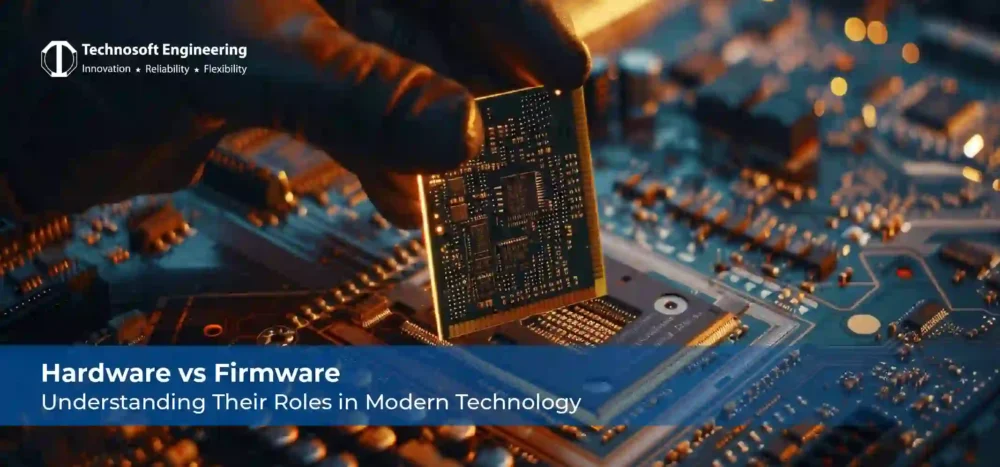
All these use the term hardware and firmware interchangeably without knowing that they do not refer to the same aspect of a system. Notably, the distinctiveness of hardware and firmware should be thoroughly understood, especially for companies now investing in advanced technology for Electrical Hardware Design Services and Firmware Development Services.
This blog intends to discuss the meaning of hardware and firmware, their various roles, and how they can power modern electronic devices.
What is Hardware?
Hardware refers to the physical, tangible components of any electronic device. These include processors, circuit boards, memory chips, screens, keyboards, batteries, and casings. However, hardware forms the very structure of a device while providing necessary interfaces through which the user can interact with it.
Characteristics of Hardware
Physical Existence: Hardware can be seen and touched.
Susceptible to Damage: It can wear or get damaged through environmental elements like heat, moisture, or bodily impact.
Requires Power to Operate: An outside electricity supply has to be furnished for all its functionality.
Replacement Over Time: Due to wear and tear, hardware components might need replacing or upgrading.
Examples of Hardware: Smartphones (processors, monitors, batteries) Laptops and Desktops (motherboards, memory chips, external gadgets for storage) Routers and Modems (community cards, antennas) Industrial Machines (controllers, power gadgets)
What is Firmware?
Firmware is embedded software put within the non-detachable memory of a hardware aspect, and it lends the hardware important instructions for easy functioning. Firmware differs from the standard software packages as it operates on a lower level and is carefully integrated with the hardware.
Characteristics of Firmware
Not Tangible: Firmware exists as code and can not be touched.
Not Destructive: Unlike hardware, firmware isn’t always destructible by physical means.
Provides Features: It acts as a bridge between the higher-level software packages and hardware.
Upgradable: One can improve the firmware, which improves capability, patches bugs, or provides security functions.
Some Examples Of Firmware Include:
- BIOS on a computer (permits boot-up and manages the hardware)
- Embedded firmware in smart devices (e.g., routers, IoT gadgets, wearables)
- Printer firmware (dealing with functions of print and modes of connectivity)
Significant Difference Between Hardware and Firmware
| Feature | Hardware | Firmware |
|---|---|---|
| Tangibility | Physical and tangible | Intangible (software code) |
| Damage Susceptibility | Prone to physical wear and tear | Cannot be physically damaged but can be corrupted |
| Functionality | Provides the physical structure and components | Provides instructions for hardware operation |
| Upgradability | Requires replacement if outdated | Can be updated via software patches |
| Dependency | Needs firmware to function | Needs hardware to operate |
How Hardware and Firmware Work Together?
The dating among hardware and firmware is symbiotic. Hardware offers the important additives even as firmware guarantees that the device works as expected.
For instance, in an Industrial IoT (IIoT) machine:
Hardware: Sensors, RFID/NFC tags, gateways, and processors accumulate statistics.
Firmware: Controls how those additives speak, the method records and manipulates the interaction with software applications.
Without firmware, hardware would be non-functional; on the other hand, firmware would have no platform to operate without hardware.
Applications of Electrical and Embedded Systems
Understanding hardware vs firmware is critical to any business investing in Electrical Hardware Design Services and Firmware Development Services.
Industrial Automation: Hardware such as controllers and sensors needs firmware to work correctly.
Smart Home Devices: The Internet of Things-enabled devices utilize firmware to connect and optimize performance.
Automotive Sector: Engine control, navigation, and safety systems utilize embedded firmware in vehicles.
Medical Instruments: Firmware updates are needed for pacemakers and MRI machines. This ensures further enhancement of accuracy and safety.
Reasons for Choosing the Right Partner in Hardware and Firmware Development
To create first-rate solutions in hardware and firmware, the professional competency should exist in applications of both fields. The solid foundation is as follows:
Integration without a hitch: Correct hardware syncing with firmware for the best performance.
Scalability: Future-proof solutions with ease of upgrades and expansions.
Security: Protection from firmware vulnerabilities and cyber-attacks.
Wrapping Up
The difference between hardware and firmware is the function each plays: the muse for hardware, at the same time as controlling capability for firmware. Together, they are essential application components for maximum modern technologies, from healthcare to automation, patron electronics, and telecommunications.
Technosoft Engineering can help you with expert Electrical Hardware Design Services and Firmware Development Services. Our skilled team develops cost-effective, customized high-stop solutions per your commercial enterprise requirements.
Connect with us now and find out how we can enhance your technology infrastructure.